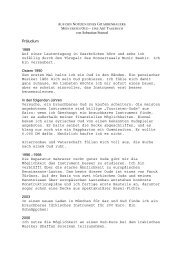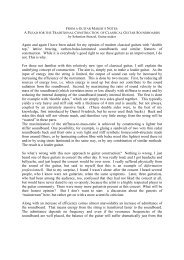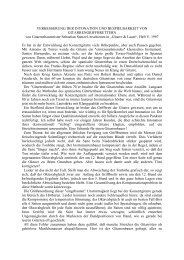INTERVIEW WITH SEBASTIAN STENZEL - Stenzel Guitars
INTERVIEW WITH SEBASTIAN STENZEL - Stenzel Guitars
INTERVIEW WITH SEBASTIAN STENZEL - Stenzel Guitars
You also want an ePaper? Increase the reach of your titles
YUMPU automatically turns print PDFs into web optimized ePapers that Google loves.
tone have a body. For me that means that the tone has plenty of volume in the middle frequencies. I’m<br />
looking for a tone that’s really a guitar tone. There are guitars, especially some modern ones, which<br />
sound more like a piano or a harp than a guitar. Historically, I’d say I’m strongly oriented towards<br />
Torres, looking for his type of sound which has often been described as “sonorous,” even though the<br />
word “sonorous” doesn’t mean much other than “pleasant sounding”.<br />
It’s also been quite common to describe sounds as vowel formants. Violin makers are in agreement<br />
that a strong a-formant is decisive for the tone quality of a violin. In my opinion, this is also true for<br />
the guitar. With the guitar there’s also the o-formant, which I think is the tonal aspect which is<br />
commonly described as “sonorous,” maybe because the word “sonorous” contains the vowel “o.” This<br />
is especially important for the bass and what produces the dark coloration. There’s a tendency in<br />
French guitar construction towards the u-formant among builders like Friederich and others. I<br />
personally don’t like that very much, but as always, it’s a matter of taste.<br />
Perhaps the most decisive factor is that there is some sort of individual sound character. I find it very<br />
important that the modulation be good and that the individual tone can be formed, especially in its<br />
dynamic, so that one can create the impression of a growing tone. And that, of course, is the greatest<br />
weakness of plucked instruments. For that reason it’s extremely important that the guitar be able to<br />
produce this effect—it’s one characteristic of a master guitar.<br />
In an information sheet about your influences you quote Heraclitus, “Polymathie noon echein ou<br />
didaskei.” “much learning does not teach understanding.” How does this relate to your work?<br />
It describes exactly the situation in which the guitar maker constantly finds himself. He can and has to<br />
exhaust all the scientific sources available to him to make the instrument better and to learn which<br />
elements of construction have which influences. He has to know the statics and understand the basics<br />
of physics. But even all that’s not enough. He has to study the old masters and gain from the<br />
experience of other guitar makers by trying to understand their concepts. And when he’s done all that,<br />
there still comes a moment when he just has to make a gut decision, “do I position the braces this way,<br />
or make them a bit different? Do I make the top a tenth of a millimeter thicker or thinner?” These are<br />
all decisions that in the end can’t be made scientifically or if one could, their solution would be so<br />
complex that no builder would take the trouble to do so. I find this apparent contradiction intriguing,<br />
that after all that we’ve learned, in the end your sense of feeling is what makes the decision. It’s not<br />
really a paradox, but rather a synthesis.<br />
I think it’s of utmost importance for a guitar maker to come to grips with both—the physical<br />
investigation of the instrument and his own intuition. The ideal sound that he has in his head must be<br />
the guiding light, so to speak, that directs all decisions. Torres put it beautifully and it’s quoted in José<br />
Romanillos’ biography of him. Torres was asked, “Don Antonio, you ought not to go to your grave<br />
without revealing the secret of you guitars for posterity”: and looking at us, smilingly [Torres]<br />
responded: “Father, I am very sorry that a man like you also falls victim of that idea that runs among<br />
ignorant people. Juanito (that is how he addressed me) has been witness to the secret many times, but<br />
it is impossible for me to leave the secret behind for posterity; this will go to the tomb with me for it is<br />
the result of the feel of the tips of the thumb and forefinger communicating to my intellect whether the<br />
soundboard is properly worked out to correspond with the guitar maker’s concept and the sound<br />
required of the instrument.”<br />
In this letter from Juan Martínez Sirvent, a close friend of Torres published in “Tárrega” by Emilio<br />
Pujol, Torres puts his finger right on the heart of the matter. While working on a top, he tests its<br />
stability, and that’s what I do as well. I hold the top and bend it. There’s a point where the top has






